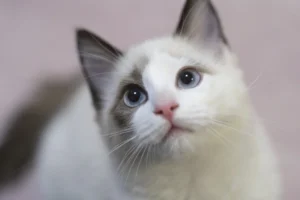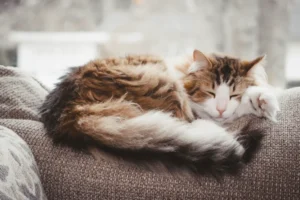Cats are beloved pets for many reasons, but one aspect that can be a bit frustrating for cat owners is dealing with shedding, especially in the winter months. Understanding why cats shed more in the winter can help you better care for your furry friend and keep your home clean.
Cats shed more in the winter to regulate their body temperature.
How Does Shedding Help Cats Regulate Body Temperature?
Cats shed their fur in winter to help regulate their body temperature. As the temperature drops, cats need a thicker coat to stay warm. Shedding allows them to get rid of their lighter summer coat and grow a denser winter one.
When cats shed, their bodies adjust to the changing weather by producing new fur. This process helps trap air close to the skin, providing insulation against the cold. Additionally, shedding removes dead hair and prevents matting, which can interfere with a cat’s ability to efficiently regulate their body temperature.
So, next time you find your cat leaving a trail of fur around the house, remember that shedding is a natural way for them to stay cozy during the winter months.
Do All Cats Shed More in Winter?
While most cats do shed more in winter to adapt to the colder weather, the extent of shedding can vary based on factors such as breed and environment. Long-haired breeds like Maine Coons and Persians tend to shed more in winter to grow their thicker undercoat, whereas short-haired breeds like Siamese may not shed as noticeably.
Environmental factors also play a role in how much a cat sheds. Indoor cats exposed to artificial heating may not shed as much as outdoor cats experiencing the natural temperature changes of the season. Providing a balanced diet rich in omega-3 fatty acids can also help reduce excessive shedding in all breeds.
To help your cat manage shedding in winter, regularly groom them with a suitable brush to remove loose fur and prevent matting. Additionally, ensure they have a warm and cozy spot to relax in during the colder months. Remember, shedding is a normal part of a cat’s seasonal adjustment to maintain optimal body temperature.
For more information on managing your cat’s shedding, check out this helpful resource on feline grooming tips: Cat Grooming Guide
How Can You Help Minimize Shedding in Winter?
Are you tired of finding cat hair all over your furniture? Fear not, there are ways to reduce shedding in your furry friend during the winter months. Regular grooming is key. Brushing your cat regularly can help remove loose hair before it ends up on your couch. Additionally, providing a balanced diet rich in omega-3 fatty acids can improve your cat’s skin and coat health, reducing excessive shedding. Regular vet check-ups are essential to rule out any underlying health issues that may be causing your cat to shed more than usual. Lastly, keeping your home well-humidified can prevent dry skin, which can lead to increased shedding.
Tips to Minimize Shedding:
- Invest in a quality brush: Regular brushing can help remove loose hair and prevent it from ending up on your furniture.
- Add omega-3 fatty acids to their diet: Consider supplements or cat food with added omega-3 fatty acids to promote healthy skin and reduce shedding.
- Use a humidifier: Maintaining proper humidity levels in your home can help prevent dry skin and excessive shedding.
- Consult your vet: If you notice a drastic increase in shedding, consult your vet to rule out any potential health issues.
Is Excessive Shedding in Winter Cause for Concern?
While some shedding in the winter months is normal as cats adjust to the changing seasons, excessive shedding could be a sign of an underlying health issue. Stress can also be a contributing factor to increased shedding in cats. If you notice bald patches, redness or irritation on your cat’s skin, or excessive grooming leading to hair loss, it’s time to seek veterinary attention.
If you suspect your cat’s shedding is abnormal, don’t hesitate to schedule an appointment with your vet. They can help determine if there are any underlying health issues causing the excessive shedding. Remember, a healthy coat is a reflection of your cat’s overall well-being, so it’s important to address any shedding concerns promptly.
For more information on cat shedding and health, check out this helpful resource: American Veterinary Medical Association – Cat Grooming Basics
What Are Some Common Mistakes Owners Make When Dealing with Winter Shedding?
It’s easy for cat owners to make mistakes when handling their feline friend’s winter shedding. One common error is not brushing your cat enough during this season. Remember, just because it’s cold outside doesn’t mean your cat stops shedding. Make sure to regularly brush your cat to help reduce the amount of loose fur in your home.
Another mistake is using the wrong tools for grooming. Not all brushes are created equal! Invest in a good quality brush that’s suited to your cat’s fur type to effectively remove loose hair.
Moreover, some owners might mistake excessive shedding for a health issue. While shedding more during winter is normal, excessive shedding can be a sign of underlying health problems. If you notice abnormal patterns in your cat’s shedding, it’s best to consult your vet for advice.
To avoid these mistakes, ensure you brush your cat regularly with the right grooming tools and keep an eye on any changes in shedding patterns as they could be a sign of a health issue.
Can Diet Affect a Cat’s Shedding in Winter?
Absolutely! A cat’s diet plays a significant role in their shedding patterns during the winter months. Incorporating key nutrients like Omega-3 fatty acids into your cat’s diet can help improve the health of their skin and coat, ultimately reducing shedding.
Additionally, hydration is essential for healthy skin and fur. Make sure your cat has access to fresh water at all times to maintain their overall coat health.
Furthermore, a high-quality diet that meets your cat’s nutritional needs can promote a shiny, healthy coat and reduce excessive shedding. Always consult with your vet to determine the most suitable diet for your feline friend.
By providing your cat with a balanced diet rich in essential nutrients and ensuring they stay hydrated, you can positively impact their shedding patterns during the winter season.
Are There Any Grooming Techniques that Can Help Manage Winter Shedding?
When it comes to managing your cat’s shedding during the winter season, grooming plays a crucial role. Regular brushing is key to reducing the amount of hair your cat sheds. Invest in a high-quality cat brush that is suitable for your cat’s coat type. Slicker brushes work well for long-haired cats, while rubber brushes are great for short-haired breeds. Brushing not only helps remove loose hair but also stimulates healthy hair growth.
Additionally, bathing your cat with a gentle cat shampoo can help reduce shedding by removing excess hair and dander. Regular check-ups with a groomer or veterinarian can also ensure your cat’s coat is in good condition and shedding is kept under control.
Fun Fact About Cats and Shedding
Did you know that cats shed their coat to regulate body temperature? In winter, cats grow a thicker coat to stay warm in the colder weather. Shedding excess hair helps them adjust to the changing temperature by allowing for better air circulation through their coat. So, next time you see your cat shedding more in winter, remember it’s their way of staying cozy and comfortable during the chilly months.
Alex, a passionate animal lover, has experience in training and understanding animal behavior. As a proud pet parent to two dogs and three cats, he founded AnimalReport.net to share insights from animal experts and expand his knowledge of the animal kingdom.









